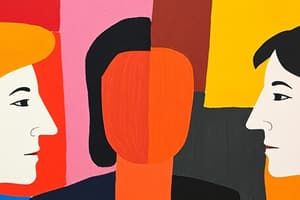Podcast
Questions and Answers
What term refers to the internal conflict that arises when someone acts prejudiced and subsequently justifies their actions?
What term refers to the internal conflict that arises when someone acts prejudiced and subsequently justifies their actions?
- Group Polarization
- Cognitive Consistency
- Social Identity
- Cognitive Dissonance (correct)
Which model reduces prejudice by promoting a collective identity that includes members of different groups?
Which model reduces prejudice by promoting a collective identity that includes members of different groups?
- Interpersonal Theory
- Strict Group Framework
- Common Ingroup Identity Model (correct)
- Ingroup Preference Model
The Dual Identity Model encourages individuals to recognize both their subgroup identity and what larger identity?
The Dual Identity Model encourages individuals to recognize both their subgroup identity and what larger identity?
- National Identity
- Superordinate Identity (correct)
- Cultural Identity
- Ethnic Identity
What does Intergroup Contact Theory suggest is necessary for reducing prejudice between groups?
What does Intergroup Contact Theory suggest is necessary for reducing prejudice between groups?
What effect describes the tendency to view outgroup members as more similar to each other than they truly are?
What effect describes the tendency to view outgroup members as more similar to each other than they truly are?
Who conducted a study that illustrated ingroup favoritism based on trivial group distinctions?
Who conducted a study that illustrated ingroup favoritism based on trivial group distinctions?
Which of the following is NOT a limitation of the Common Ingroup Identity Model?
Which of the following is NOT a limitation of the Common Ingroup Identity Model?
What is a potential outcome when one member of an outgroup is portrayed negatively?
What is a potential outcome when one member of an outgroup is portrayed negatively?
What does the Common Ingroup Identity Model aim to promote in terms of intergroup relations?
What does the Common Ingroup Identity Model aim to promote in terms of intergroup relations?
Which of the following best describes the Dual Identity Model?
Which of the following best describes the Dual Identity Model?
What does the Outgroup Homogeneity Effect refer to in social psychology?
What does the Outgroup Homogeneity Effect refer to in social psychology?
What is the primary goal of Intergroup Contact Theory?
What is the primary goal of Intergroup Contact Theory?
Cognitive dissonance in the context of intergroup relations refers to which of the following?
Cognitive dissonance in the context of intergroup relations refers to which of the following?
According to Realistic Conflict Theory, prejudice arises primarily from:
According to Realistic Conflict Theory, prejudice arises primarily from:
Which criticism relates to the effectiveness of real-world intergroup contact?
Which criticism relates to the effectiveness of real-world intergroup contact?
What is a central component in understanding prejudice as identified in research?
What is a central component in understanding prejudice as identified in research?
What is the cognitive component of prejudice primarily associated with?
What is the cognitive component of prejudice primarily associated with?
Which measure assesses physiological responses related to prejudice?
Which measure assesses physiological responses related to prejudice?
Which type of prejudice is characterized by negative attitudes towards LGBTQ+ individuals?
Which type of prejudice is characterized by negative attitudes towards LGBTQ+ individuals?
What role does social learning play in the development of prejudice?
What role does social learning play in the development of prejudice?
Which approach suggests that bringing groups into contact can reduce prejudice?
Which approach suggests that bringing groups into contact can reduce prejudice?
What does the term 'outgroup homogeneity effect' refer to?
What does the term 'outgroup homogeneity effect' refer to?
Which process involves the reinforcement of prejudiced attitudes through external rewards and punishments?
Which process involves the reinforcement of prejudiced attitudes through external rewards and punishments?
What is characterized by individuals simultaneously identifying with two distinct groups?
What is characterized by individuals simultaneously identifying with two distinct groups?
Flashcards
Social Categorization
Social Categorization
Classifying people into groups based on shared characteristics like race, gender, or age.
Ingroup
Ingroup
The group you belong to.
Outgroup
Outgroup
The groups you do not belong to.
Ingroup Favoritism (Minimal Group Paradigm)
Ingroup Favoritism (Minimal Group Paradigm)
Signup and view all the flashcards
Realistic Conflict Theory
Realistic Conflict Theory
Signup and view all the flashcards
Outgroup Homogeneity Effect
Outgroup Homogeneity Effect
Signup and view all the flashcards
Common Ingroup Identity Model
Common Ingroup Identity Model
Signup and view all the flashcards
Intergroup Contact Theory
Intergroup Contact Theory
Signup and view all the flashcards
Prejudice
Prejudice
Signup and view all the flashcards
Discrimination
Discrimination
Signup and view all the flashcards
Social Identity Theory
Social Identity Theory
Signup and view all the flashcards
Minimal Group Paradigm
Minimal Group Paradigm
Signup and view all the flashcards
Dual Identity Model
Dual Identity Model
Signup and view all the flashcards
Measuring Prejudice
Measuring Prejudice
Signup and view all the flashcards
Stereotypes
Stereotypes
Signup and view all the flashcards
Operant Conditioning and Prejudice
Operant Conditioning and Prejudice
Signup and view all the flashcards
Social Learning and Prejudice
Social Learning and Prejudice
Signup and view all the flashcards
Media and Prejudice
Media and Prejudice
Signup and view all the flashcards
Genes and Prejudice
Genes and Prejudice
Signup and view all the flashcards
Study Notes
Prejudice Definition
- Prejudice is a hostile or negative attitude toward a group of people solely based on their group membership.
- It can be based on race, gender, or religion.
Measuring Prejudice
- Association Task: Measures implicit bias (automatic associations).
- Skin Conductance: Measures emotional responses.
- Donations: Measures behavioral prejudice (how much money is donated).
- Self-Report Questionnaires: Measures explicit bias (surveys on attitudes).
Three Components of Prejudice
- Cognitive: Stereotypes—generalizations about a group assigning characteristics to all members.
- Example: Believing all members of a specific race are lazy.
- Affective: Emotional responses towards a group (hatred, anger, contempt).
- Example: Feeling anger towards a group.
- Behavioral: Acts of discrimination (unjustified negative actions).
- Example: Refusing to hire someone due to their ethnicity.
Common Types of Prejudices
- Homophobia: Prejudice against LGBTQ+ individuals.
- Transphobia: Prejudice against transgender individuals.
- Sexism: Gender-based prejudice.
- Racism: Race-based prejudice.
- Antisemitism: Prejudice towards Jewish people.
Origins of Prejudice
- Operant Conditioning: Prejudice is learned through rewards and punishments.
- Social Learning: Learning from others (especially family and peers).
- War and Conflict: Hostility and prejudice arise from intergroup conflicts.
- Direct Experience: Personal negative encounters with a group foster prejudice.
- Classical Conditioning: Negative experiences are associated with specific groups.
- Media: Exposure to negative group stereotypes in media.
- Genes: Evolutionary factors may predispose individuals to ingroup bias.
Social Categorization and Ingroup/Outgroup Bias
- Social Categorization: Classifying people into groups based on shared characteristics (e.g., race, gender, age).
- Ingroup: The group to which an individual belongs.
- Outgroup: Groups to which an individual does not belong.
- Social Identity Theory: People derive self-esteem from the groups they belong to. Prejudice arises when people favor their ingroup to boost their self-image.
Minimal Group Paradigm
- Tajfel et al. (1971) demonstrated even meaningless group distinctions lead to ingroup favoritism and prejudice against outgroups.
Realistic Conflict Theory
- Prejudice arises from competition for limited resources or goals (e.g., conflicts for prizes).
- Cognitive Dissonance: Justifying prejudiced actions to reduce internal conflict ("they deserve it").
Outgroup Homogeneity Effect
- The tendency to perceive outgroup members as more similar to each other than they actually are.
Reducing Prejudice
- Common Ingroup Identity Model: Encouraging people from different groups to see themselves as part of a larger, inclusive group.
- Dual Identity Model: Acknowledges subgroup identities (e.g., ethnicity, gender) and broader group identities.
- Intergroup Contact Theory: Interacting with outgroup members can reduce prejudice.
Studying That Suits You
Use AI to generate personalized quizzes and flashcards to suit your learning preferences.




